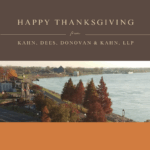UPDATED April 1, 2020, to reflect IRS expanded application of payroll tax credits for employers
UPDATED March 19, 2020, to reflect that President Trump signed H.R. 6201 into law
UPDATED March 18, 2020, to reflect passage of H.R. 6201 by the U.S. Senate
Originally published March 17, 2020
In response to the coronavirus (COVID-19) outbreak, President Trump signed into law the Families First Coronavirus Response Act last night.
The Families First Coronavirus Response Act consists of two components that address paid sick leave: the Emergency Family and Medical Leave Expansion Act (Emergency FMLA), which makes significant amendments to the Family and Medical Leave Act, and the Emergency Paid Sick Leave Act (Emergency PSLA).
Pursuant to the Families First Coronavirus Response Act, the Emergency FMLA and Emergency PSLA will take effect no later than April 2, 2020, and expire on December 31, 2020.
The following summarizes key provisions of the legislation.
The Emergency Family and Medical Leave Expansion Act
The Emergency FMLA provides that employees of a private employer with fewer than 500 employees may take up to 12 weeks of job-protected leave. Eligible employees must have been employed for at least 30 calendar days by the employer in order to use such leave for the following reason: The employee is unable to work or telework due to the need to care for a child under the age of 18 if the child’s school or place of child care has been closed or the child care provider is unavailable, due to a public health emergency.
Under the Emergency FMLA, the first 10 days for which an employee takes leave may consist of unpaid leave. After the 10 days of unpaid leave, an employer must provide paid leave at two-thirds of the employee’s regular rate of pay, for the number of hours the employee would otherwise be scheduled to work. The amount of paid leave under Emergency FMLA can be no more than $200 per day and $10,000 total. The Secretary of Labor has the authority to issue regulations for good cause to exempt small business with fewer than 50 employees from these requirements if the viability of the business as a going concern is jeopardized.
Employer Tax Credits: An employer is allowed a credit against its withheld federal income taxes, the employee share of Social Security and Medicare taxes, and the employer share of Social Security and Medicare taxes with respect to all employees. The available credit is in an amount equal to 100% of the qualified family leave wages paid by the employer each quarter. The qualified family leave wages that may be taken into account when calculating the tax credit available to the employer is limited to $200 for any day that the employee is paid qualified family leave wages, and $10,000 total for each employee. If there are excess credits, such credits shall be treated as an overpayment, which can be refunded or applied to future tax obligations.
The Emergency Paid Sick Leave Act
The Emergency PSLA provides that employers with fewer than 500 employees, and covered public employers, are required to provide paid sick leave to an employee who is unable to work or telework for the following reasons:
- The employee is subject to a federal, state, or local quarantine or isolation order related to COVID-19;
- The employee has been advised by a health care provider to self-quarantine because of COVID-19;
- The employee is experiencing symptoms of COVID-19 and is seeking a medical diagnosis;
- The employee is caring for an individual subject or advised to quarantine or isolation;
- The employee is caring for a son or daughter whose school or place of care is closed, or child care provider is unavailable, due to COVID-19 precautions; or
- The employee is experiencing substantially similar conditions as specified by the Secretary of Health and Human Services, in consultation with the Secretaries of Labor and Treasury.
Under the Emergency PSLA, full-time employees are entitled to 80 hours of paid sick time, and part-time employees are entitled to the typical number of hours that they work in a typical two-week period. An employer must provide paid leave up to $511 per day ($5,110 total) where an employee takes leave for reasons (1), (2), or (3) stated above; and up to $200 per day ($2,000 total) where an employee takes leave for reasons (4), (5), or (6) stated above.
Under the Emergency PSLA, employees may use the paid sick leave immediately, regardless of how long the employee has been employed by the employer. Paid sick time under the Emergency PSLA does not carry over from year to year.
Employer Tax Credits: n employer is allowed a credit against its withheld federal income taxes, the employee share of Social Security and Medicare taxes, and the employer share of Social Security and Medicare taxes with respect to all employees. The available credit is in an amount equal to 100% of the qualified sick leave wages paid by the employer each quarter. The amount of qualified sick leave wages taken into account for the tax credit for each employee is limited to $200 for any day and $511 for any day in the case of leave under (1), (2), or (3). If there are excess credits, such credits shall be treated as an overpayment, which can be refunded or applied to future tax obligations.
We will continue to update you about this and other major federal and state measures addressing the ever-developing COVID-19 pandemic.
For additional information on this or any related topic, please contact any of the following KDDK labor and employment law professionals:

Partner
jfulcher@KDDK.com
(812) 423-3183, ext. 2263

Partner
mmcanulty@KDDK.com
(812) 423-3183, ext. 2233

Partner
croelle@KDDK.com
(812) 423-3183, ext. 2286

Attorney
orobinson@KDDK.com
(812) 423-3183, ext. 2217

Attorney
ngolding@KDDK.com
(812) 423-3183, ext. 2216




